Danny Cram moves jauntily between the forge and anvil, heating steel on the fire and hammering it into shape while keeping up a running banter with the crowd. With a flourish, the blacksmith presents a hefty-sized nail to a young visitor to Fort Langley National Historic Site. It’s longer than the width of her hand and quite fierce looking.
We ooh and aah over the unique souvenir before Cram moves on to a more complicated ornamental hook.
“Those little curls at the end are actually functional, they’re not there to look pretty,” he stresses. “They do look pretty, but they are actually there to serve a purpose. It actually is an earlier form of a clothes hanger. It’s just a S hook with the little curls because if you had the point or a rough edge it would go through your clothes. So you put the curl on it and it doesn’t go through your clothes.”
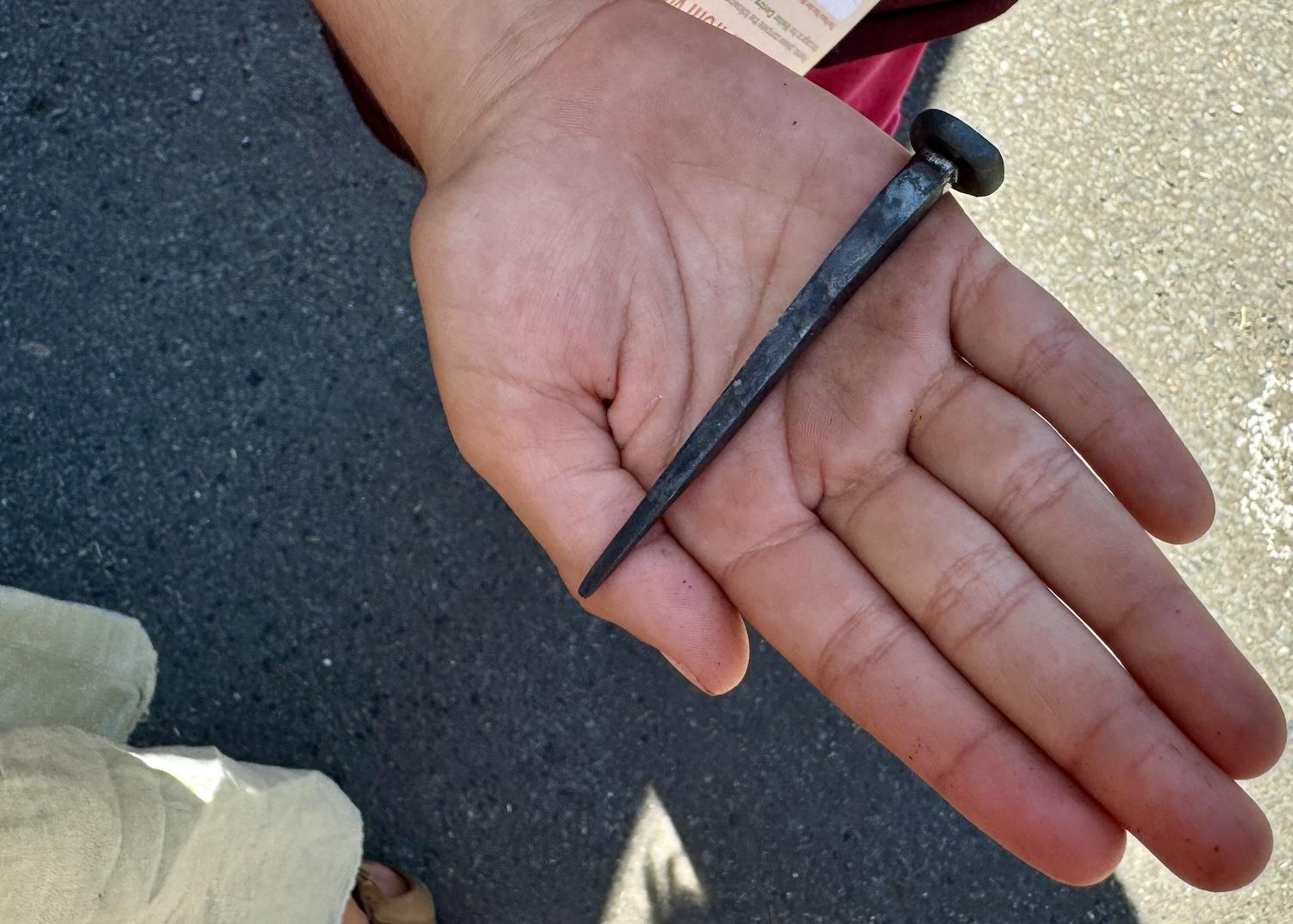
A young visitor to Fort Langley National Historic Site shows off the nail that blacksmith Danny Cram made and gave to her/Jennifer Bain
Every time the nail stock Cram is using cools and hardens, he steps back to the fire to make it soft and malleable again.
“They didn’t make a lot of beautiful things here,” Cram admits. “I don’t really have a record of them making anything officially, certainly nothing officially for trade was made here that was beautiful. But we do find bits and pieces left over from archaeological records, decorated tinder boxes and stuff like that.”
The hook will be for me, but it can’t be banged out quickly like a nail. That’s okay, I’m in no rush. I’ve driven to Fort Langley, about an hour from Vancouver in southwestern British Columbia, to learn about this historic fur trade fort and Parks Canada’s push to include Indigenous perspectives in the story.

The trilingual welcome sign at Fort Langley National Historic Site is in English, French and an Indigenous language/Jennifer Bain
The fort sits on nearly 11 acres of unceded territory of the q̓ʷɑ:n̓ƛ̓ən̓ (Kwantlen), Máthxwi (Matsqui), se’mya’me (Semiahmoo), and q̓ic̓əy̓ (Katzie) First Nations.
There are 12 structures inside the palisade walls, including the original Storehouse, three reconstructed buildings (the Big House, Servants’ Quarters and Northeast Bastion) and Tradish’s Ancestor Café run by Sarah Mierau of the Sayisi Dene First Nation.
The visitor center, maintenance compound, artefact facilities, picnic shelter and orchard area are outside the walls. A riverfront property — across an escarpment, road and railway — isn’t actively used.
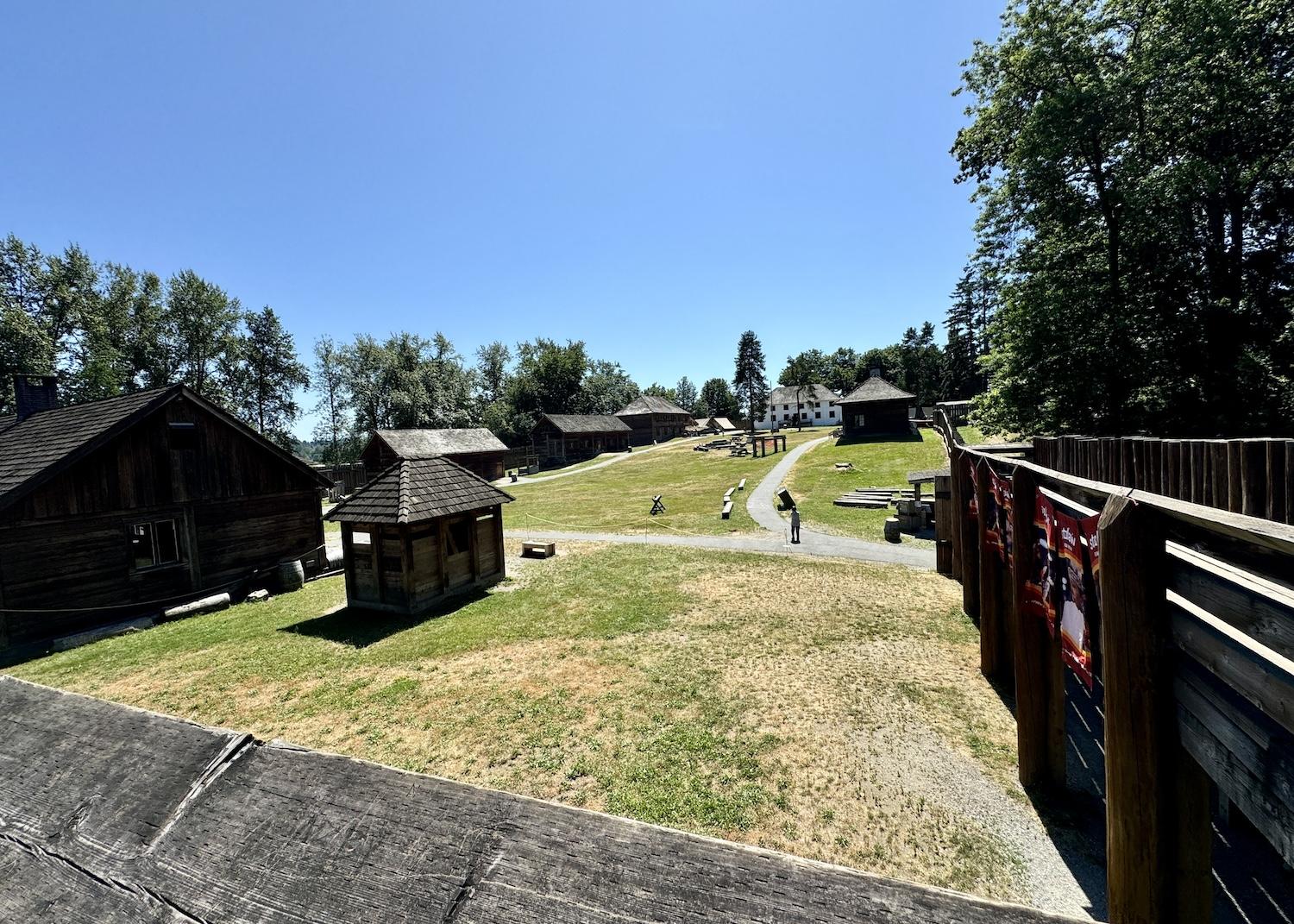
A view of the original and reconstructed buildings inside the walls at Fort Langley/Jennifer Bain
“The history of Fort Langley is part of the story of the fur trade in Canada,” Parks Canada says in a draft management plan for the site. “The decisions made at this place tell a larger story of the establishment of the British presence on the Pacific Coast and a key milestone in the building of Canada as a nation.”
Fort Langley is on the south bank of the Fraser River near McMillan Island, which remains the home of the Kwantlen community. The longhouses and canoes of the Kwantlen people — a major trading partner and intermediaries in the trade with other Indigenous communities — once bordered the island’s shores.
As Parks Canada explains, the Hudson’s Bay Co. (HBC) founded Fort Langley in 1827 to secure British-controlled trade on the west coast of North America and to maintain a competitive interest in the Pacific maritime fur trade. In 1839, the post moved upriver to higher ground to be closer to farming operations.
It was from here that the HBC began exporting salmon to places like Hawaii’s Sandwich Islands where many Indigenous Hawaiians were recruited to work at HBC forts and trading posts.

Heritage interpreter Dave Helberg gives an introduction to Fort Langley by a reconstructed "trade window" where Indigenous people once brought furs and fish to swap for European goods like blankets and tools/Jennifer Bain
After the Columbia River was abandoned as a fur trade route in 1848, Fort Langley replaced Fort Vancouver as the HBC’s main trans-shipment depot for transporting goods to and from inland trading posts west of the Rocky Mountains.
Indigenous Peoples, their territories and labor were foundational to the fur trade, Parks Canada says. Posts were often built near Indigenous settlements, trading routes and meeting places, and became important sites of economic, social and cultural exchange.
It was Kwantlen First Nation’s Chief Whattlekainum who urged the HBC to trade salmon and cranberries, and so salted salmon went to Hawaii and cranberries were shipped to California. By 1848, Fort Langley was making more money from salmon than furs. (To delve deeper into the canned salmon era, I visited the Gulf of Georgia Cannery National Historic Site in nearby Richmond).
By the 1850s, Fort Langley was a hub for boat building, blacksmithing, farming, cranberry packing and fish curing. In 1858, spurred by an influx of American gold prospectors to the region, the British government chose Fort Langley as the venue to declare the establishment of the new British colony of British Columbia. The proclamation was a major milestone in Canada’s path to nationhood.
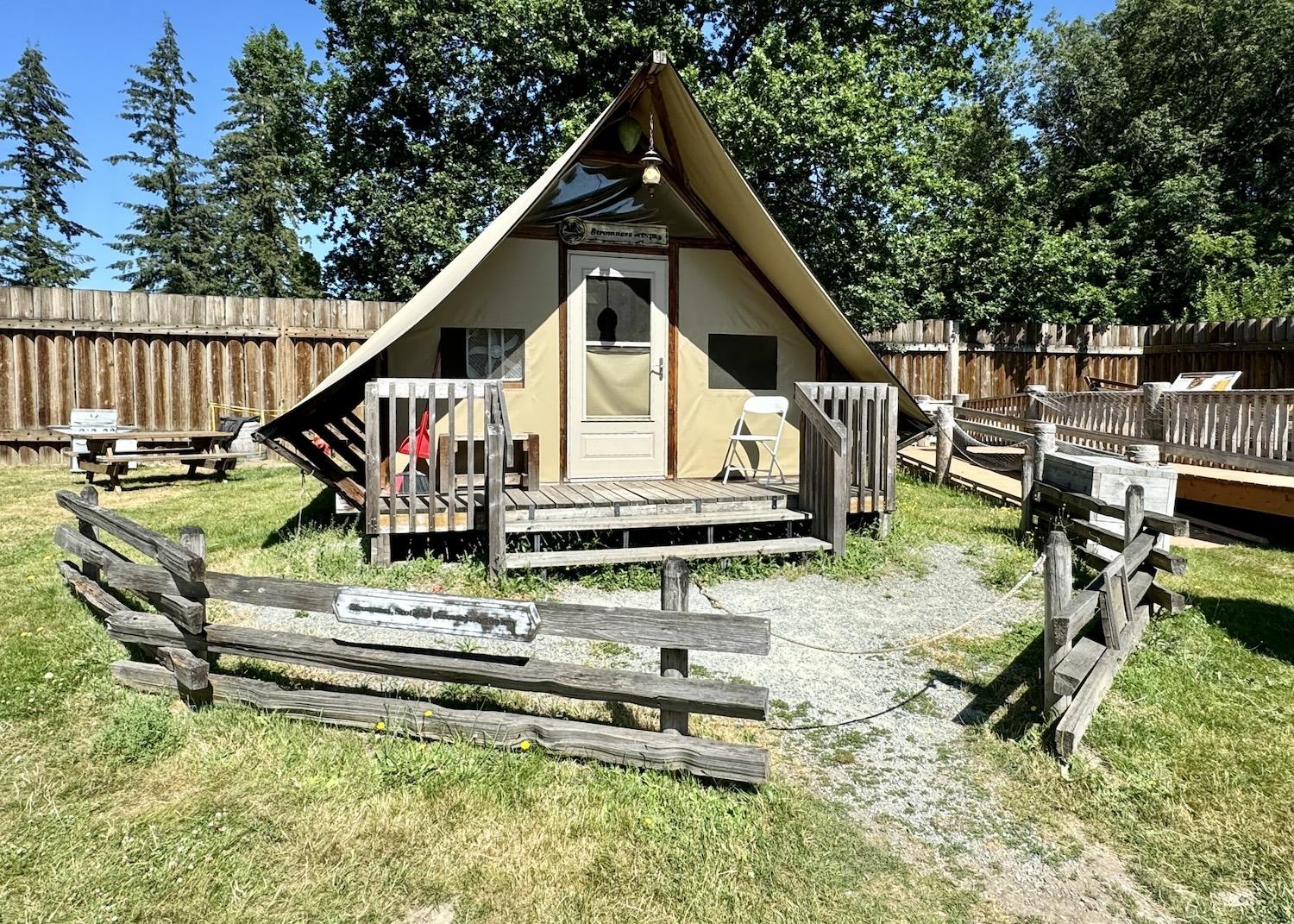
Fort Langley has five oTENTiks, a tent/cabin hybrid that Parks Canada rents to overnight guests/Jennifer Bain
Now under Parks Canada’s care, the fort is open year-round. More than 100,000 people visited in the years just before the pandemic. That number dropped but rebounded to about 74,000 last year.
You can stay overnight in five oTENTiks (a type of roofed accommodation), pan for gold and watch coopering, baking and musket demonstrations. But everybody naturally gravitates to the blacksmith shop.
“I just love kids here,” says Cram. “They’re so fascinated — and their parents are, too, they just don’t want to show it. It’s really funny because the kids will ask questions no problem and the parents want to so they whisper to their kids to ask the question.”

In the Ancestor Café at Fort Langley, blacksmith Danny Cram chats over bannock (an Indigenous fry bread) and jam/Jennifer Bain
Over bannock (an Indigenous fried bread) slathered with strawberry sweetgrass and blackberry sage jams in the Ancestor Café, the 61-year-old blacksmith explains how he stumbled into this unique job.
Cram started out as a statistician research analyst, helped his early childhood educator wife run a home-based pre-school, and later helped develop student education systems. He has six children, including three who were adopted from Ethiopia and China.
About a decade ago, he asked a farrier to make a knife for his son-in-law for Christmas and wound up taking lessons from her. “Four lessons and I was hooked,” he remembered.
Cram bought an anvil and took more classes from the Vancouver Island Blacksmith’s Association, delighted by classmates who were “characters, like from a Dickens novel, and from all walks of life.”

The fire at Fort Langley's blacksmith shop/Jennifer Bain
While puttering around in semi-retirement in 2017, he learned from an association member about an extremely rare blacksmith job at Fort Langley.
“I was not the best blacksmith in the province by far because I had only been at it for three years, but I thought I bet you they’re looking for a chatty blacksmith,” he predicted. “That’s my thing and typically blacksmiths aren’t chatty to the same extent. It draws characters. Because it’s a hand-eye skill, and there’s not a lot written about how to do it, and there’s no official training, you kind of have to have a passion for it — and it’s quirky.”
Cram nailed the job interview, which revolved around childcare and how to manage crowds before being given a few hours to make three things in the fort’s blacksmith shop while giving a public talk.
“It was summertime and when you arrived in the blacksmith shop, and opened up, a crowd appeared. Everybody comes to the blacksmith shop. Being a blacksmith in any given site, I always say, is like being Mickey Mouse in Disneyland. People want to be there, you don’t have to convince them.”

There's usually a crowd gathered in front of the blacksmith shop at Fort Langley where Danny Cram works four days a week/Jennifer Bain
There must have been 100 visitors that day. “The three items turned out horribly, because I was just having so much fun talking to people,” Cram confesses. “I may not be a great blacksmith. but I can chat. And the blacksmith shop is a perfect venue for stories.”
He got the job, and loves how Parks Canada’s messaging about the fort — “a monument to unilateral colonialism” — is evolving. The colonial HBC flag is no longer flown at the fort. Kwantlen Elders work at the fort. Métis craftsman Pat Calihou built a traditional bateau like the kind his ancestors once used to transport goods during the fur trade.
Back at the blacksmith shop after lunch, a crowd gathers as Cram demonstrates how to light a fire and launches into stories about his bottom-blast, side-draft forge.
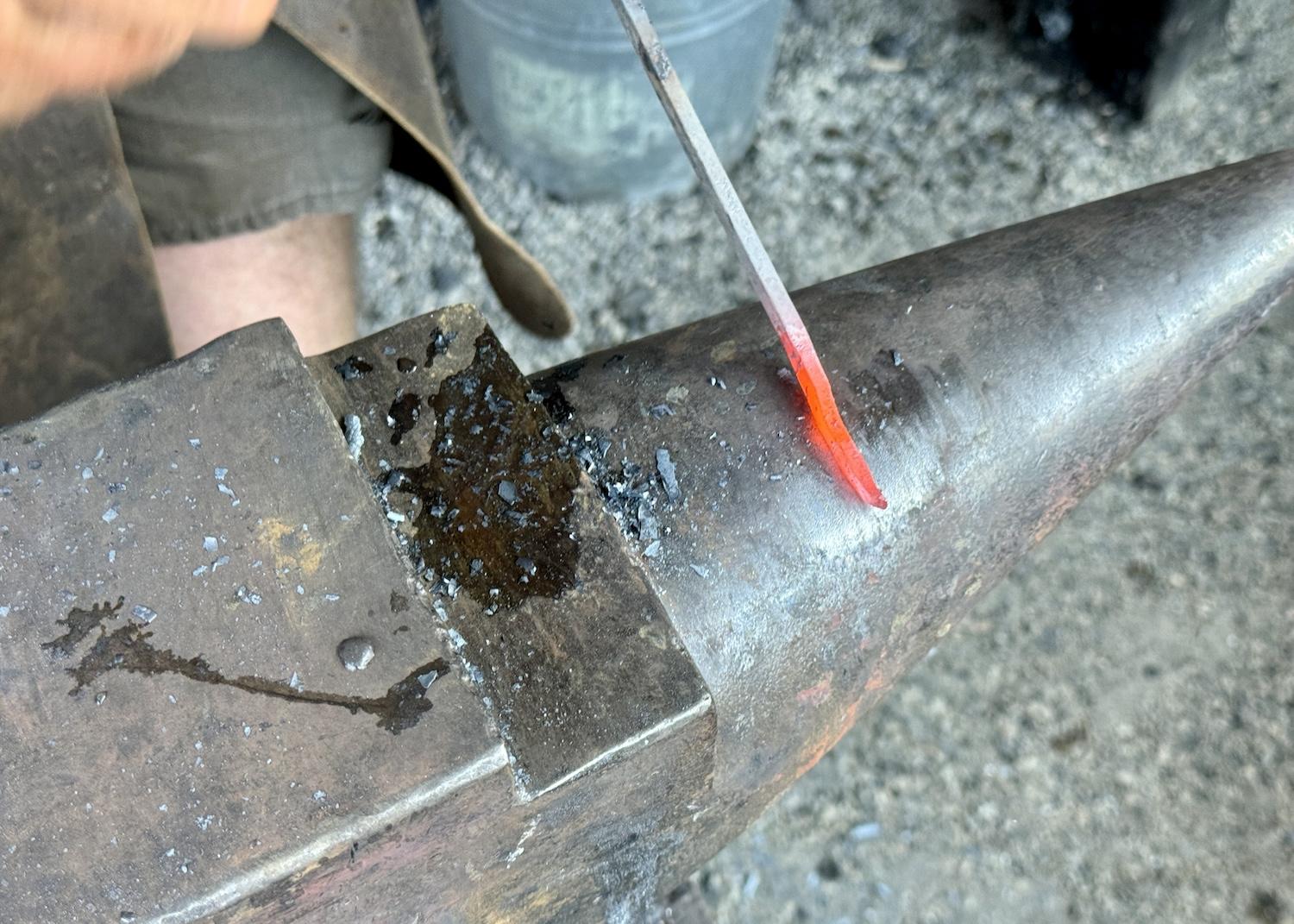
Once you heat steel, it becomes malleable. This piece is becoming a nail/Jennifer Bain
Before the Industrial Revolution, he explains, everything made from metal was made by a smith. Blacksmiths could make cutlery and a couple kinds of locks, but were generalists. He considers himself a heritage smith because “no blacksmith turned down a power tool ever” but he is only allowed to work with his hands at the fort.
The HBC didn’t want to hire expensive master smiths who might leave and set up their own shops, just “country smiths” who would be content to fix things and make functional tools instead of producing trade goods.
“So I tell people this place is like Fort Walmart, and the blacksmith is like the janitor,” says Cram. “That’s the level of skill that you need.”

A wall of homemade tools at Fort Langley National Historic Site's blacksmith shop/Jennifer Bain
If a fort didn’t have a blacksmith and the carpenter needed a chisel, you would have to send to England for one, and that’s six months one way by sail and six months back. So it’s not like the blacksmith is exceptional, but it’s a lot better than trying to wait a full year to have it done.”
The blacksmith shop is now full of tools and hammers. There are nails, cutlery and chains, the letters HB and even a lovely rose.
Historic blacksmith shops were filled with broken tools that could either be fixed or forged into something else. “Blacksmiths have always been about recycling and reuse,” says Cram, who loves reusing truck coil springs from steel from junkyard recyclers.

An ornamental hook made by Fort Langley blacksmith Danny Cram for the writer/Jennifer Bain
My ornamental hook is almost done.
“You can see how long it takes to make something ornamental, which is why Hudson’s Bay blacksmiths were instructed don’t make things ornamental, because it’s just a hook and it would probably take me 20 seconds to make one, but to make it ornamental takes a lot longer,” Cram tells the crowd. “This is just a general store for trappers so there’s not a big demand for fancy hooks. There’s a demand to fix tools and make things work.”
The crowd has thinned by the time Cram hands over my hook, a delicate beauty that reminds me of a graceful seahorse.
“You got a present,” says the only other person standing around in the heat. “I want a present, too.”

Blacksmith Danny Cram works on a hook at an anvil inside Fort Langley's blacksmith shop/Jennifer Bain
Cram chuckles and agrees to make another, as long as she keeps it quiet.
“This is like really unexpectedly interesting,” muses the woman who’s getting the hook.
“It is. It catches a lot of people off-guard,” Cram agrees. “A lot of people say `oh I’d love to be able to do that’ or `this is a lost art.’ But there’s nothing lost about it. It’s a practice skill and you learn it by practicing again and again. Before I was making hooks, I was making nails because that’s how you learn to be a blacksmith. You have to make between 800 and 1,000 a day. When you can do that, you make other things.”

Fur trade era blacksmiths were generalists tasked with making and fixing tools and other useful items/Jennifer Bain
When people — usually kids — ask Cram what his favorite thing to make is, he tells them he has ADHD and his “favorite thing to make is the next thing.” Blacksmiths like him have always been generalists who enjoy making a huge array of things.
Back in the fur trade era, hooks had infinite uses and were made by the thousands. They helped hang clothing, tools, cooking gear and food like beef and geese.
It takes about 17 minutes but Cram finally finishes his second hook, which is deliberately asymmetrical and has an entirely different personality than mine.

A Fort Langley visitor cradles an asymmetrical hook made for her by blacksmith Danny Cram/Jennifer Bain
We solemnly promise to treasure these unexpected gifts and learn that fort often hosts winter classes to make things like pierced lanterns, pierced stars and even decorative roses.
Cram is pleased to have sparked a newfound appreciation of blacksmithing in us and everyone else who visited today.
As we part ways, he reminds me: “It’s a very human type of thing to make, and like to make, tools."

They may not have been in Fort Langley during the fur trade, but decorative roses are now a hit with national historic site visitors/Jennifer Bain

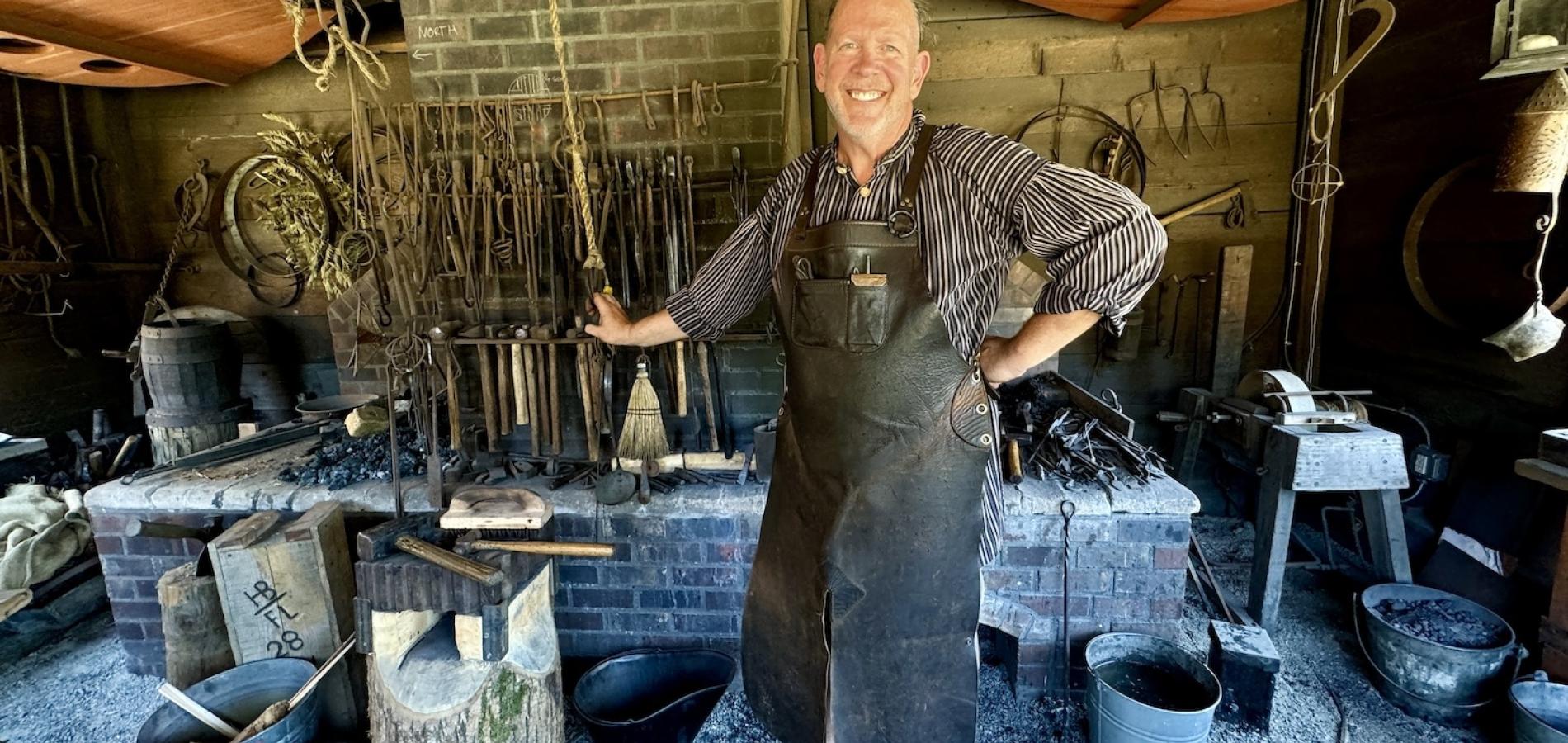

 Support Essential Coverage of Essential Places
Support Essential Coverage of Essential Places







Comments
The only thing stronger than the steel that Daniel Cram forges is his virtue. Fort Langley must be a wonderful place to visit and knowing Dan for so many years, it is no surprise that he is a highlight for so many that visit. I look forward to watching his presentation and sharing in his excitement when he looks at the crowd with his inspiring smile.